
Android 14 has launched and is available for a number of Pixel devices. Thanks to the Android 14 QPR builds it is also available as part of the regular Beta program. That means it isn’t quite as smooth as you might have expected. Luckily, you can downgrade from Android 14 back to Android 13 anytime on your phone if you are not having so much fun. Here’s how to get started.
If you would like to try Android 14 on your device ahead of the full stable release later this year, we have a handy guide on how to sideload the latest update on your device available here. Due to the various support windows for the Google Pixel series, Android 14 is officially available for Pixel 4a 5G, Pixel 5, Pixel 5a, Pixel 6, Pixel 6 Pro, Pixel 6a, Pixel 7, and Pixel 7 Pro.
No other devices are set to be supported, at least at this stage but we do expect the upcoming Pixel Fold, Pixel 7a, and Pixel Tablet, will be able to get Android 14 when available. It’s highly likely that the Pixel 8 and Pixel 8 Pro will launch with Android 14 pre-installed later this year.
Another thing to note is that the downgrade process has not changed since the Google Pixel series launched back in 2016. That means it might be familiar to longtime users and Android fans, but it’s not necessarily as widely known by those new to the mobile platform – hence this walkthrough. That said, thanks to the Android Flash Tool, it’s easier than ever to flash factory images on Pixel hardware.
Before you push forward it’s important to note that you’re going to need to do a few things, and there are some limitations here that you should be aware of before you can revert back to a stable Android 13 build.
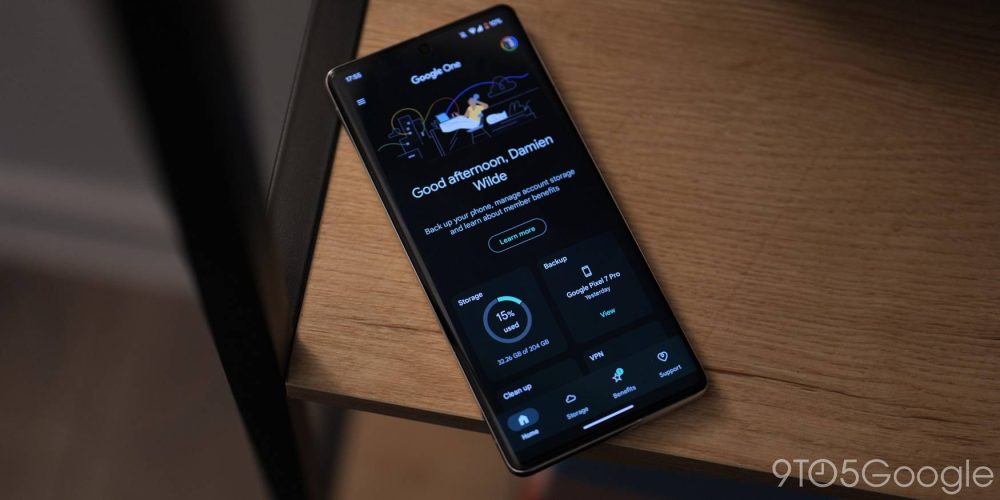
It is important that you back up all of your data before even attempting this. You WILL lose your device data, as this method requires a FULL device wipe, and it will be wiped several times during this process.
We have also added Android Flash Tool instructions for those wanting to use the Chrome browser-based flashing tool. This method is the easiest for anyone that is not confident using Terminal or Command Prompt to get back to an older operating system build.
Quick method 1 : Unenroll from the Beta
A super quick way to get your phone back to the stable update channel during the public preview phase is to unenroll from the beta. The dedicated Android 14 Beta page will show any devices that are eligible to join the public preview, while also allowing you to opt out of future updates.
Just tap the “Opt out” button and this will send an OTA update to your device. However, this OTA will fully wipe all of the data on your phone and then install the latest public or stable version of Android.
If you are running any developer preview builds on your Google Pixel, sadly, this quick method is not available, but you will see a notification to confirm this. Should you be running a developer preview build, you’ll need to use this guide.
Quick method 2: Use the Android Flash Tool
The quickest manual method to downgrade your phone from any version of Android to another supported version on your device is to use the Android Flash Tool. It works from your browser and requires just a few simple things from you. Skip to Step 6a of this guide to get started.
Table of contents
- Quick method 1 : Unenroll from the Beta
- Quick method 2: Use the Android Flash Tool
- 1. Download and install Android SDK Platform-Tools package
- 2. Enable USB debugging and OEM unlocking
- 3. Download the Factory Image for your device
- 4. Boot into device bootloader
- 5. Unlock the bootloader
- 6a. Enter the flash command
- 6b. Access the Android Flash Tool
- 7. Relock the bootloader (optional)
- 8. Reboot your phone
Video — How to downgrade from Android 14 on Google Pixel
For more video content subscribe to 9to5Google on YouTube.
Note: This written guide is also tailored for Windows users, meaning that the process may vary for those using MacOS or Linux.
1. Download and install Android SDK Platform-Tools package
You’ll need to use ADB or Android Debug Bridge to downgrade your current Android 14 build to an older version. We recommend installing the unzipped platform-tools package on your desktop for quick access when running commands. You can download the latest platform-tools zip file from here.
Alternatively, Nexus Tools from Corbin Davenport offers a very simple way to ensure that you have the very latest version of Platform-Tools on your Windows, Mac, or Linux machine at all times. Nexus Tools has been written in Dart, so it can run on Linux, macOS, Windows, Windows Subsystem for Linux, and Chrome OS. Once Nexus Tools is finished, you can run adb, fastboot, and other commands with zero problems or issues.
2. Enable USB debugging and OEM unlocking
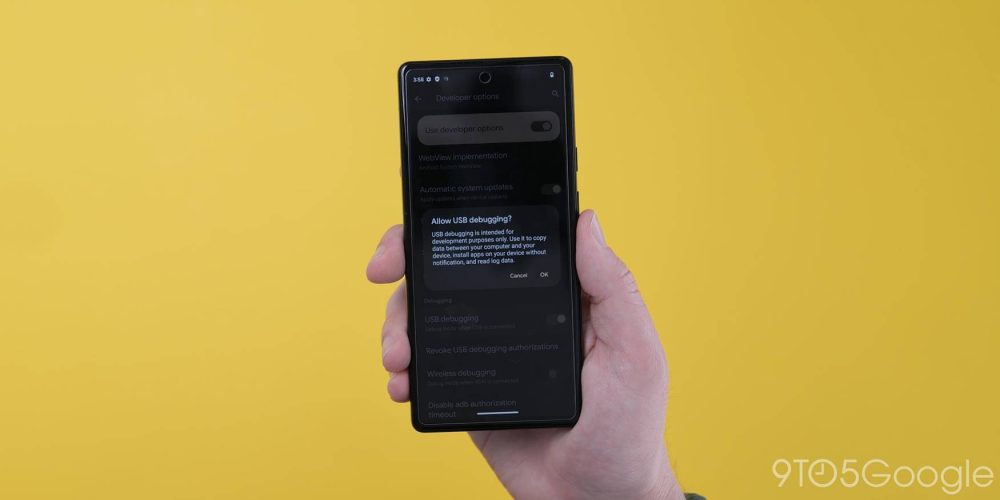
Firstly, ensure that you have Developer Options enabled on your Pixel. You can do that by heading to your device Settings > About phone, now tap “Build number” until a message confirms that you have Developer options enabled.
Now you need to head to Settings > System > Advanced > Developer options (you may need to expand a hidden menu for this). Before we are ready to continue, you will need to scroll down and enable “OEM unlocking” as this is integral for further steps. Now scroll slightly further down to the “Debugging” section and tap the “Allow USB debugging” option.
3. Download the Factory Image for your device
This is necessary for the Android 14 downgrade process. You’ll need to download the correct Factory Image for your device. This is essentially just a blank slate for your smartphone or snapshot of that particular Android build at that time. You can grab it from Google’s Factory Image OTA hosting site, which contains all Factory Images for Pixel devices.
You will need to add this file and unzip its contents to the platform-tools folder for access later on.
Note: Do not extract into an internal sub-folder, just extract all files into the main platform-tools folder.
4. Boot into device bootloader
This can be done in a couple of ways. The simplest way is to connect your device to your Windows PC and open the platform-tools folder and typing “cmd” into your file manager address bar, then pressing the Enter key. This will open a Command Prompt window in the right place. Now enter the following command to start the adb daemon:
Windows:
adb reboot bootloaderMac: ./
adb reboot bootloader
Your Pixel device will now load into the bootloader, which is where we’ll need to be to send some commands.
Alternatively, you can press and hold the Power button and volume down key until you see the Android figure lying down. Now you will need to briefly press and hold the power button and volume up button before releasing the volume up key. Using the up and down volume buttons, you can scroll to select “enter fastboot.”
5. Unlock the bootloader

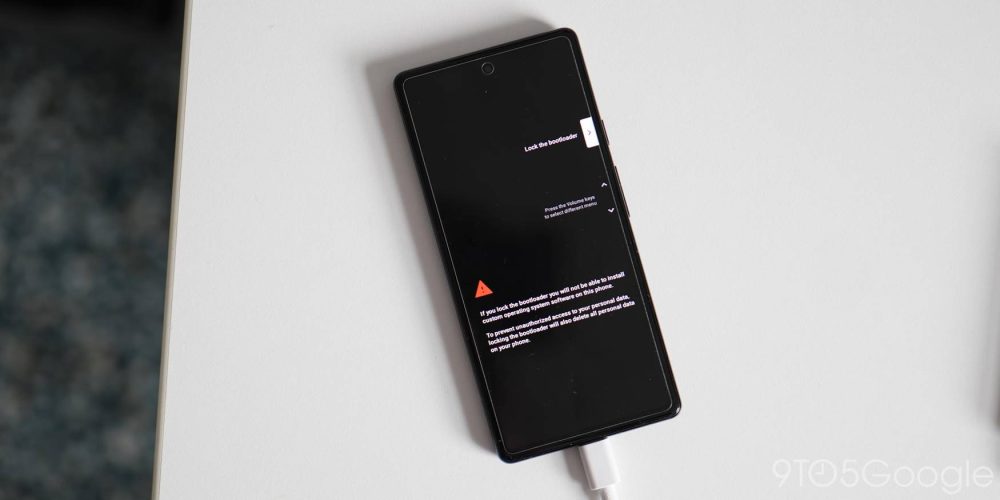
Unlocking the bootloader is necessary for the flashing process, as, unfortunately, you can’t flash a Factory Image and downgrade your Android version using the slightly simpler ADB sideloading method. This is a pretty simple process, though. When using your command-line interface, enter the following command:
Windows:
fastboot flashing unlockMac: ./
fastboot flashing unlock
You will get a slightly daunting message on your display warning you that unlocking the bootloader may cause device instability. Using the physical volume keys, choose the “Unlock the bootloader” option and confirm your selection by pressing the power button. Restart your Pixel, as this process will wipe your smartphone.
We will also need to skip the device startup process to re-enable USB Debugging in preparation for the next step. Once you have done so, ensure your Pixel is connected to your PC, and you’ll need to enter the bootloader on your device with the following command again:
Windows:
adb reboot bootloaderMac:
./adb reboot bootloader
6a. Enter the flash command
With all of your Factory Image files extracted into the platform-tools folder and accessible. You can now run the following command (with your open Command Prompt/PowerShell window):
Windows:
flash-allMac:
./flash-all
Your Pixel will now begin the process of downgrading Android 14 Developer Preview back to Android 13, which can and will take a few minutes. Leave the Command Prompt window open and when the process has finished, you will see a completion message.
6b. Access the Android Flash Tool
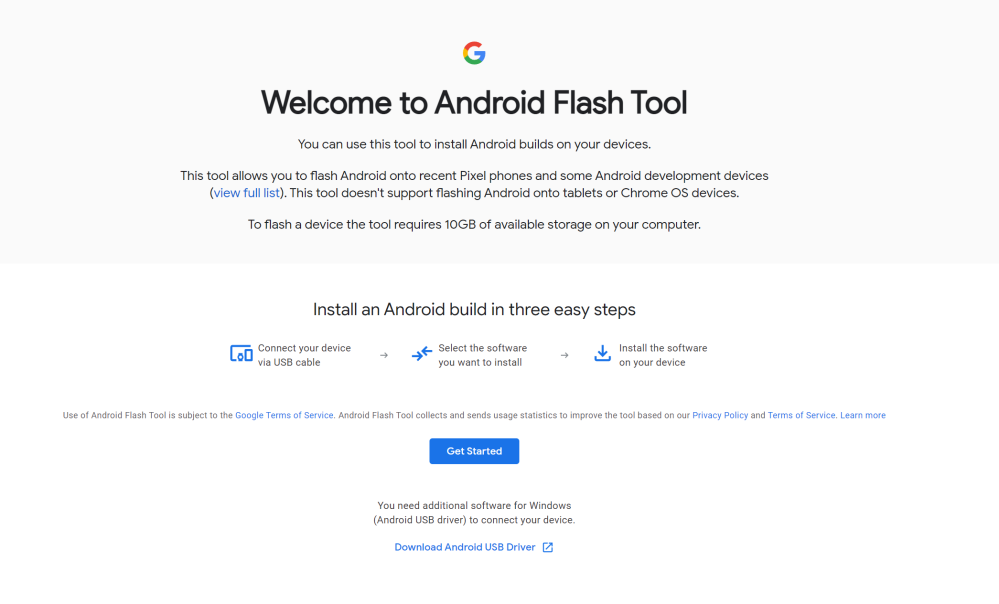
A slightly easier method to downgrade your device is to use Google’s handy Android Flash Tool. This effectively mimics the command line process but does so in a much more friendly Chrome browser window. Provided you have followed the previous steps the process is simple.
Connect your Pixel to your computer via USB-C cable and head to the dedicated firmware page for your specific device. You can find the direct links for all eligible devices below:
- Pixel 4a 5G (“bramble”)
- Pixel 5 (“redfin”)
- Pixel 5a (“barbet”)
- Pixel 6 (“oriole”)
- Pixel 6 Pro (“raven”)
- Pixel 6a (“”bluejay”)
- Pixel 7 (“panther”)
- Pixel 7 Pro (“cheetah”)
Find the right build or the build that you desire for your specific handset and click the “Flash” link, which is found alongside the build “Version.” Doing this will now launch the Android Flash Tool page, and the firmware you have chosen will automatically be loaded ready to be installed on your device.
Tapping the “Get Started” button will initiate a pop-up you will need to accept to allow ADB access. This also means that your Pixel will be able to communicate with your computer and the downgrade process from Android 14 back to Android 13 (or another available software build) can commence.
A new page will appear explaining the steps (which we have detailed above). From here click the “Add a new device” button and provided that your smartphone is connected and in the prerequisite Recovery mode, it should be recognized. Select your Pixel and double-check the software build if the one that you want to install. Also from here, you can relock the bootloader without needing to use command line too — saving time as part of this process. If you’re happy click “Install” and then “I accept” when the “License Agreement” dialog box appears.
This installation process should now take a few minutes to install but ensure that your device is securely connected and does not disconnect during this process. You’ll be greeted with a new page that confirms “Software successfully updated” while your Pixel should now boot into the software that you have selected.
7. Relock the bootloader (optional)
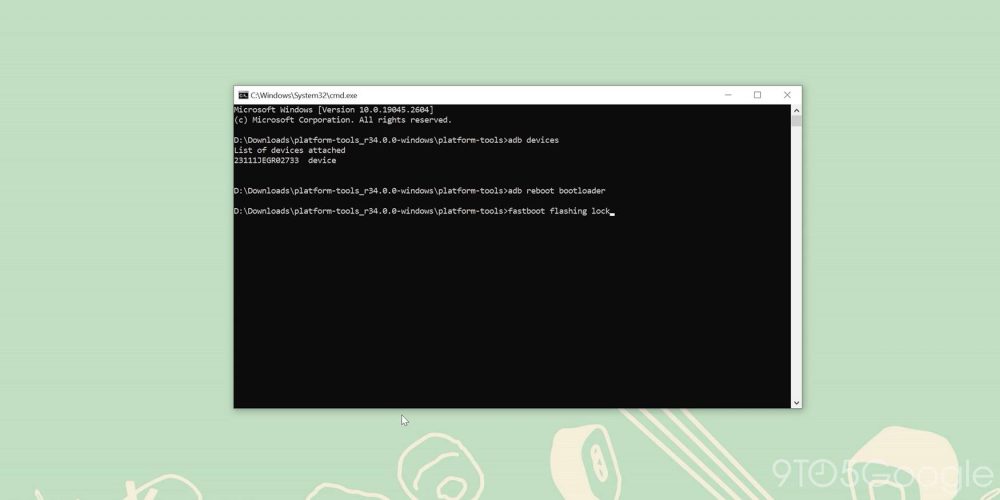
This is an optional step but is needed if you want to get future OTA updates. Otherwise, you’ll see a pop-up splash screen with a warning each time you reboot your device. For those using the Android Flash Tool, there is a neat toggle that will take care of this for you (as noted above). If you have done this already, you can skip this step entirely.
You will need to go through the device setup process again, which you can skip wholesale. From here, go back and re-enable USB debugging from step No. 2 — your bootloader is unlocked so OEM unlocking should be grayed out.
Plug your device back into your Windows PC and open your platform-tools folder and reopen a Command Prompt window using the “cmd.” Enter the following command to quickly load into your device bootloader:
Windows:
adb reboot bootloaderMac:
./adb reboot bootloader
Now we can re-lock the bootloader by entering the following:
Windows:
fastboot flashing lockMac:
./fastboot flashing lock
On your Pixel, using the volume keys, scroll to the “lock the bootloader” option and tap the power button to accept. When confirmed, “locked” will appear on screen within the bootloader menu.
Note: This process will wipe your device a further time once you reboot your Pixel.
8. Reboot your phone

You can now disconnect your device and reboot as you have successfully downgraded from the Android 14 Developer Preview, Beta, or stable release back to Android 13. It should now load into the device setup process, allowing you to sign up and enjoy your stable Android build.
If you have or encounter issues then be sure to try a different USB-C cable. In some cases we have seen complaints from people using USB-C to C cables. We have found that USB-A to C cables are more reliable but that will depend on whether you use Windows or Mac OS.
This method can be stacked, so if you have a device that shipped with Android 10 or Android 11, then you can go back to an older version if you wish. However, in the case of Android 12, it becomes a little more confusing. Tensor-powered handsets including the Pixel 6, 6 Pro, and 6a are not able to go back to Android 12 despite shipping with this software version due to anti-rollback protection. You’re stuck on Android 13 or higher on Pixel 6, 6 Pro, 6a, Pixel 7 and 7 Pro if you update or upgrade. All other Made by Google phones can go back to older supported builds.
We do not recommend rolling back devices to older builds unless you have no other option. This can bring about various device security risks and further potential device issues. That said, if you do choose to downgrade from one Android version to another, then you do so at your own risk. On older builds, the Pixel 4 will also lose access to Face Unlocking should you go back from Android 11 to Android 10.
Dylan Roussel and Kyle Bradshaw contributed to this guide.
FTC: We use income earning auto affiliate links. More.






Comments